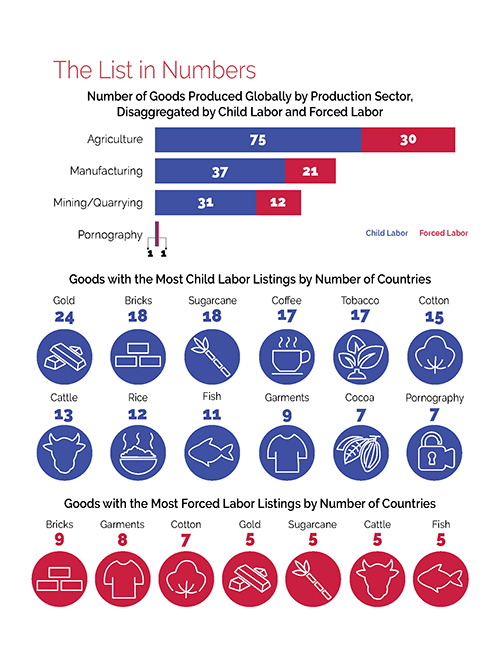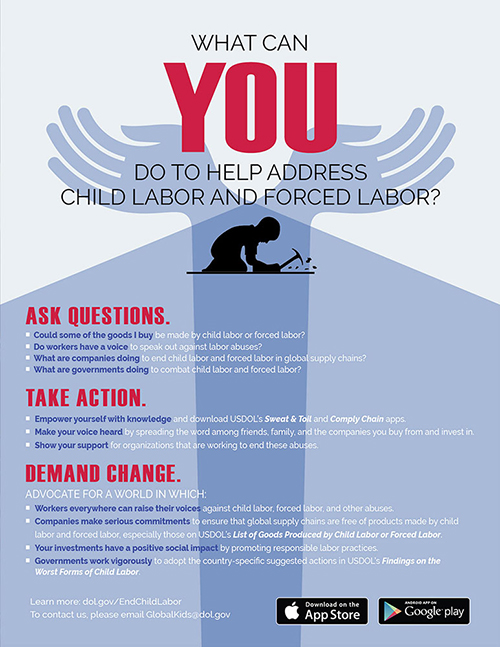List of Goods Produced by Child Labor or Forced Labor
The Bureau of International Labor Affairs (ILAB) maintains a list of goods and their source countries which it has reason to believe are produced by child labor or forced labor in violation of international standards, as required under the Trafficking Victims Protection Reauthorization Act (TVPRA) of 2005 and subsequent reauthorizations. The List of Goods Produced by Child Labor or Forced Labor comprises 159 goods from 78 countries and areas, as of September 28, 2022.
ILAB maintains the List primarily to raise public awareness about forced labor and child labor around the world and to promote efforts to combat them; it is not intended to be punitive, but rather to serve as a catalyst for more strategic and focused coordination and collaboration among those working to address these problems.
Publication of the List has resulted in new opportunities for ILAB to engage with foreign governments to combat forced labor and child labor. It is also a valuable resource for researchers, advocacy organizations and companies wishing to carry out risk assessments and engage in due diligence on labor rights in their supply chains.
The countries on the List span every region of the world. The most common agricultural goods listed are sugarcane, cotton, coffee, tobacco, cattle, rice, and fish. In the manufacturing sector, bricks, garments, textiles, footwear, carpets, and fireworks appear most frequently. In mined or quarried goods, gold, coal and diamonds are most common.
ILAB published the initial TVPRA List in 2009 and updated it annually through 2014, following a set of procedural guidelines that were the product of an intensive public consultation process. ILAB now updates and publishes the List every other year, pursuant to changes in the law.
Procedural Guidelines
On January 25, 2024, ILAB's Office of Child Labor, Forced Labor, and Human Trafficking published Procedural Guidelines for the development and maintenance of the List of Goods from countries produced by child labor or forced labor in violation of international standards.
| Country/Area Sort ascending | Good | Exploitation Type |
|---|---|---|
| Tanzania | Child Labor | |
| Tanzania | Child Labor | |
| Tanzania | Child Labor | |
| Tanzania | Child Labor | |
| Tanzania | Child Labor | |
| Tanzania | Child Labor | |
| Tanzania | Child Labor | |
| Tajikistan | There are reports that children ages 14-17 and some as young as 7 are forced to work during the annual cotton harvest in Tajikistan. Monitoring teams discover multiple cases of compulsory mobilization across several districts of the country each year. In these cases, school officials mobilize classes to work in the harvest and teachers supervise them in the fields. Some children receive threats regarding exams, grades, and even expulsion from school for refusal to work. The children are typically sent to the fields after class hours. Farmers negotiate directly with the schools to mobilize the students to work, and the schools may keep some or all of the children's wages. Some of the children are required to pick a quota of 66 pounds of cotton daily. |
Child Labor, Forced Labor |
| Taiwan | There are reports that adults are forced to work in the production of fish on Taiwan’s distant-water fishing fleet. Taiwan’s fleet is the second largest in the world, with more than 1,100 fishing vessels, comprising approximately 36 percent of the world’s tuna longliner fleet, and operating on the high seas and in the exclusive economic zones of more than 30 countries. An estimated 35,000 migrant workers are employed by the fleet. The majority of these workers are recruited overseas, mostly from Indonesia and the Philippines, by agencies that sometimes deceive workers with false information regarding their wages and the terms of the contracts, and require the workers to pay recruitment fees and sign debt contracts. According to various sources, numerous incidents of forced labor have been reported on Taiwan-flagged fishing vessels. While on board the vessels, workers’ identity documents are often confiscated, and the crew spends months at sea without stopping at a port of call, and they are forced to work 18 to 22 hours a day with little rest. Workers face hunger and dehydration, live in degrading and unhygienic conditions, are subjected to physical violence and verbal abuse, are prevented from leaving the vessel or ending their contracts, and are frequently not paid their promised wages or have food and lodging fees illegally deducted from their wages. |
Forced Labor |
| Suriname | Child Labor |
your hand? Download ILAB's Sweat & Toil App today!
Are you a company looking to fight child labor and forced labor in supply
chains?





